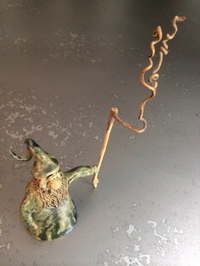It was one of those clear, crisp, February nights when the stars are shining bright, the snow looks blue and wonder is afoot. As my son and I stepped outside to stargaze, Geoffrey turned to hug me and said, "Happy Birthday Mom!" We spontaneously started to waltz clumsily across the yard, laughing. As we darted back through the door, I thought, "Romantic moments don't just happen with your husband. If you are open to it, romance is all around you."
Mother's Day can trigger the opportunity to take stock on how you're doing as a mom -- what do you want to start doing, stop doing or keep doing? The thing I am most proud of is nurturing my son's sense of romance. I like to think that his kindness toward others, curiosity about people, respect for differences, creativity in his work and play and confidence about what is possible for himself and others evolved from this perspective. Here are five ways that this nurturing of romance played out.
1. Create the setting. I hung a picture of a house, at night, with one bedroom light on near his bed. Each night I would ask him to tell me all about what was going on in that house. With animal photos on the wall, art supplies and a dash of glitter, our basement became a land of adventure. A few whimsical additions to our home gave Geoffrey different worlds to escape to, inviting his imagination and sense of adventure.
2. Explore your backyard. We lived in a stone house that was built in 1784. In those days, you picked a spot for your trash and dumped it in the woods. Two-hundred years later, each rainstorm uncovered a glimpse of someone's trash that would become our treasure. We dug out shards of glass from old milk and medicine bottles, then displayed them on the windowsill.
The woods behind the house harbored deer, snakes, snapping turtles and all sorts of animals. We talked about the way Indians assigned meaning to animals, so instead of just spotting deer, he saw "shapeshifters." A hawk soaring overhead was not just a bird, but rather, it was a messenger from another world.
A backyard full of "trash" and critters became our personal zoo and dig site. Geoffrey learned to see the extraordinary in the ordinary.
3. Teach him art. When Geoffrey was 6, we enrolled him in an intergenerational-clay class. He hinted at his romantic side upon receiving his first mound of clay. He poked his finger into it and announced, "I feel the heartbeat of the clay!"

For three hours every Saturday morning, Geoffrey had space to reflect and create tangible evidence of his imagination, so he developed the ability to observe, focus and create.
4. Travel to historic sites. We made two pilgrimages to England to see the land of King Arthur. Geoffrey stepped past a cow field to see the ruins of Camelot. We twirled at the top of Glastonbury Tor, the alleged site of Avalon. He got a chance to try archery and falconry in a castle near Sherwood Forest. On our visit to Althrop, Princess Diana's childhood home, we literally bumped into her brother Charles Spencer near the stables. These fairytale sites and people became real to Geoffrey.
We also explored the historical sites, large and small, in our hometown. Seeing the actual places where stories took place helped Geoffrey to see the invisible beneath the visible.
5. Respect imagination. The goal was to find presents that would spark Geoffrey's imagination. When he was 4, it was a jester's cap with brightly colored velvet panels. He opened the box, tried it on and quietly took it to his bedroom. That night, and nearly every night for over a year, he carefully put it on before he went to sleep. Did it feel like protection, or some sort of thinking cap? I did not ask because I did not want to break the spell or make him self-conscious. I took his feelings about the hat seriously.
When he had friends over for an overnight, I respectfully asked to borrow the hat, telling him I really needed to wear it that night so that his friends did not tease him. I was vigilant about encouraging his imagination and honoring his ideas, and I hope this contributed to Geoffrey's confidence and sense of joy as an adult.
In Thrive, Arianna Huffington talks about wonder as a measure of success. Romance -- that imaginative, sentimental way of imputing mystery and beauty to people, places or things -- is one of the greatest gifts you can give a child and a key ingredient of wonder. My son is 25 now. When he tells me about his rich conversations with his girlfriend and how they explore ideas and cities together, I think the lessons had a lasting effect. He continues to see the romance all around us.